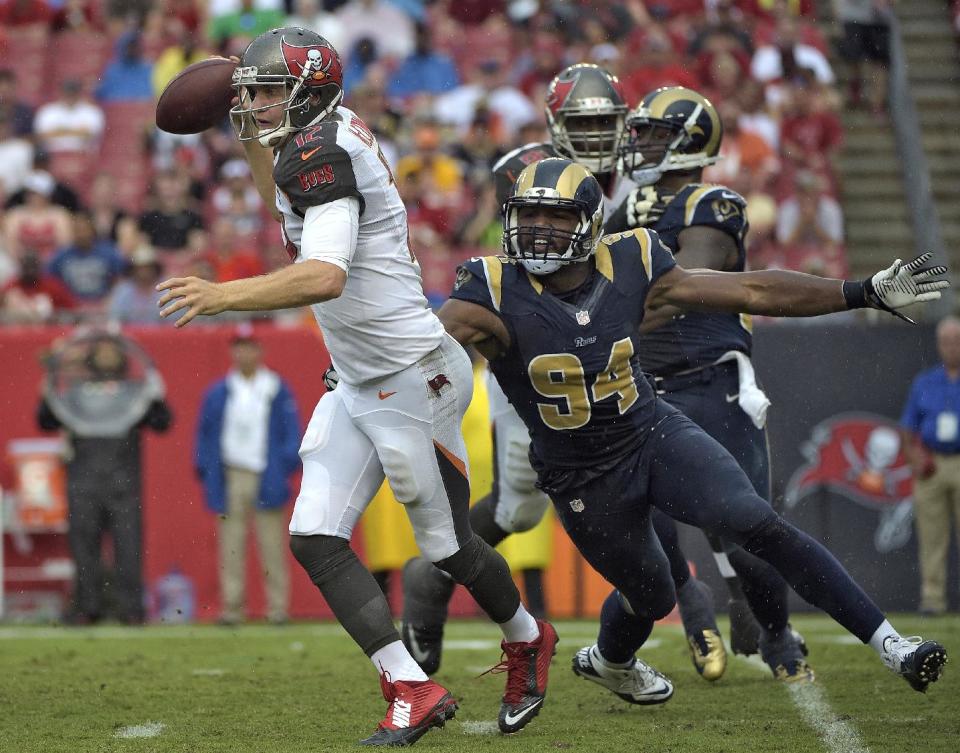J.J. Watt vs. Robert Quinn deals: What's pass-rushing market look like in actual dollars?

The St. Louis Rams' Robert Quinn signed a four-year contract extension on Saturday that was widely reported to be worth $66 million, including $41.2 million guaranteed, but the actual value of Quinn's guarantee is far less than that, according to contract analysis conducted by Yahoo Sports. In fact, Quinn's extension fully guarantees him only $15.7 million at the time of signing.
Initially reported figures for NFL contracts are rarely "fully guaranteed." Instead, those numbers generally include partial guarantees, which can misrepresent the amount of money a player actually stands to make. For instance, J.J. Watt was reported to have received $51.8 million guaranteed from the Houston Texans, when the actual fully guaranteed number at the time of signing was $30.8 million, according to Yahoo Sports' contract analysis.

While Quinn is likely to realize at least $35.1 million of the contract and could realize up to $57 million if he stays healthy through the 2019 season, there are foreseeable scenarios that could leave him with far less. For instance, based on the language in Quinn's contract, if he were to suffer a catastrophic injury this year, but recover well enough to pass a team physical prior to next season, the Rams could cut him by the fifth day of the league year for diminished physical ability. If that were to occur, Quinn would have received only the $15.7 million that was fully guaranteed at the time he signed his extension.
If Watt were to suffer a catastrophic injury under the same scenario as the one posed for Quinn, he'd receive $30.8 million based on the language in the six-year extension he recently signed.
In each of the first four years of each player's extension, Watt is making roughly $10 million more than Quinn. Some of that difference can be attributed to the fact that Watt signed a longer-term deal than what Quinn did with the Rams. Longer commitment to the team, team provides a bigger commitment to the player.
Had Quinn signed his deal prior to Watt's record-setting contract for a defensive player, it would have been difficult to argue that it was anything less than solid given the fact that he had two years left on his rookie deal. But once Watt struck a deal with two years remaining on his original contract, Quinn was given a considerable amount of leverage that could have allowed him to secure more fully guaranteed money and more total value.
That said, there are a lot of moving parts in a contract negotiation. Quinn and his representatives essentially made a bet that the 24-year-old will hit the market in the prime of his career at age 29 or sign another extension at or around the same time. If Quinn can stay healthy until then, a big if in such a brutal sport, he'll have an opportunity to ink a third deal that would almost assuredly be more lucrative than the contract he just signed. Watt, on the other hand, is contractually obligated to the Texans until he's 32.
How will these contracts affect other pass rushers from the stellar 2011 draft class? Players in line to hit free agency – barring franchise or transition tags – or receive extensions in the next two years: Jets DL Muhammad Wilkerson, Saints DE Cameron Jordan, Chargers DE Corey Liuget, 49ers OLB Aldon Smith and Broncos OLB Von Miller.
Unless one or more of them can successfully argue that they are demonstrably better than Quinn, which is highly unlikely, teams are likely to lean on his contract as a loose benchmark. Depending on the terms of the deals they are discussing (i.e., if they are discussing a four-year extension), it could be used as an absolute ceiling.
San Francisco 49ers linebacker Patrick Willis provides an example of how one player's contract can stunt the value available to others in the market. If you look at the non-pass-rushing linebacker market, New England's Jerod Mayo, San Francisco's NaVorro Bowman and Pittsburgh's Lawrence Timmons are all receiving less than $10 million per year. Why? Because Willis' deal was for roughly $10 million per year and none of those players effectively argued that he was better than Willis, and thus worth more money, on a per-year basis.
While it is unclear how things will play out for Watt and Quinn in the long-term, this much is clear: The devil in these contracts is in the details, and the longer you wait for clarity on their actual value, the better your view of the market.

 Yahoo Sports
Yahoo Sports 